“Dari Abu Hurairah r.a. Rasulullah SAW bersabda: “Akan timbul di akhir zaman orang-orang yang mencari keuntungan dunia dengan menjual agama. Mereka menunjukkan kepada orang lain pakaian yang dibuat dari kulit kambing (berpura-pura zuhud dari dunia) untuk mendapat simpati orang banyak, dan percakapan mereka lebih manis daripada gula. Padahal hati mereka adalah hati serigala (mempunyai tujuan-tujuan yang jahat).
Allah swt. Berfirman kepada mereka, “Apakah kamu tertipu dengan kelembutan Ku?, Ataukah kamu terlampau berani berbohong kepada Ku?. Demi kebesaran Ku, Aku bersumpah akan menurunkan suatu fitnah yang akan terjadi di kalangan mereka sendiri, sehingga orang yang alim (cendikiawan) pun akan menjadi bingung (dengan sebab fitnah itu).” (HR At-Tirmizi)
May 13th 1969 – The Correct View (part 1)
It has been 40 years since the bloody riots of 1969. Today, I would like to offer my prayers to the people that had lost their lives in that fateful day. Many have talked about what had happened. Many books were published. Many theses and opinions were written to elaborate and discuss the events prior, during and after the incident.
Some say that this bloody blotch in our history books should be a lesson learned. Some say we should bury this ghost of our past. Some even made the effort to distort history by misrepresenting the facts.
Three weeks ago, the Regent of Perak put to task people who write destructive political books in order to satisfy their own selfish agenda. His Majesty had commented on something that is very crucial in highlighting the despicable act of rewriting our history to fit a certain ulterior motive. What more, all the so-called facts presented in the books are highly presumptuous, misguided and intended only to achieve a divisive propaganda.
One such book that I would like to highlight is the book by Dr Kua Kia Soong entitled : Declassified Documents on the Malaysian Riots of 1969″.
From reading the book, readers will ultimately come to three conclusions:
1) Tun Abdul Razak masterminded the May 13 racial riots as a form of coup d’etat from Tunku Abdul Rahman
2) Datuk Harun Idris led Umno Youths to spontaneously launched an unprovoked attack towards the chinese people
3) The racial riots were not the fault of the racist opposition or the subversive communist movement
These are the conclusions the author of the said book would like his readers to believe. He strengthened his thesis by providing several dockets of ‘declassified documents’ in his book.
Now, from the term ‘declassified document’, what does a layman normally associate it with?
It must have been a top secret document sanctioned by the government to be kept as classified and confidential from the eyes of the public. It must have been documents with valid and unshakable truths that are so damning, it would have been prudent to be kept as a secret. Correct?
But as you read the book, these ‘declassified documents’ were nothing more than articles taken from the now defunct Far Eastern Economic Review magazine. Its writer, a journalist named Bob Reece communicated directly with the FEER’s HQ in London and British High Commission.
These documents were ‘obtained’ by Kua Kia Soong from the Public Records Office in Kew Gardens, London – and so he stated in his book.
In fact, these were the documents deemed by Kua Kia Soong as the priceless ‘declassified documents’. They have no intrinsic value and were not data laden with factual analyses except to notify the readers that the documents were actually, only a personal opinion of a British journalist!
Kua Kia Soong rubbished all the investigative research and study of the White Paper of the NOC on what actually had happened. He relied mainly on Bob Reece’s writings and dispatches between foreign correspondents.
If he thinks that his book is a thorough research and also the definitive version of what had really happened 40 years ago, then he is gravely mistaken.
This book can safely be classified as a highly prejudice book vent on achieving a specific propaganda which is detrimental to the nation’s social harmony. Why do I say that? Please refer to the three lies conclusions above.
This article came about from what Raja Nazrin had said three weeks ago:
If this trend continues to grow, I fear that it will create an unhealthy writing culture, a writing culture which nurtures lies, a writing culture which is unethical and ready to ignore fact, and one that will have a negative influence on the development of the people’s minds.
And this article will try its best to straighten and debunk the propaganda which had been swimming within the minds of the ignorant racists.
Now in order to ascertain what really happened that day, we need to study it holistically. Kua Kia Soong had purposely left out vital events preceding May 13. I would have thought a research director with a doctorate would have been more diligent in espousing his hypothesis. One must always begin with the root cause, the trigger, the reaction and finally the aftermath. In a historical event of this magnitude, one must evaluate every event that took place in chronological order before we can decide on the conclusion. One must know the historical background of the mood of the people on that day.
Instead, he concluded them before making the research and work on it backwards. That is why the book was written in a manner which denigrated Tun Abdul Razak as a chinese killer and a usurper of Tunku Abdul Rahman. After making this conclusion, he then proceeded in cherry picking excerpts from the so-called ‘declassified’ documents (which were nothing but mere telegrams and wired news) of British field reporters to justify his conclusion.
That is a flawed approach and it does not work that way.
Let us dissect and re-address the May 13 episode as what it is and what it is not.
The first of many factual errors the author committed was in the Introduction section whereby he averred that Dato Onn revolted against the British in 1946 in order ‘to grant citizenship rights to the non-Malays’ (pg. 13 of the book).
That was a factual mistake. In 1946 which was the birth year of Umno, Dato Onn had opposed the Malayan Union because it would usurp the power of the Malay Rulers, and allow the British to rule Malaya as their colony (according to Tunku Abdul Rahman’s Political Awakening book pg. 1).
Furthermore, Dato Onn was fighting the Malayan Union because the Malays saw the jus soli (right of territory) principle in the citizenship clause for the Malayan Union as too generous because it stipulated that individuals born in Chinese-majority Singapore were included even though Singapore was excluded from the Malayan Union structure. The Malays’ worst fears seemed to be coming true; they would be reduced from a nation to a mere community, and a minority one at that; in a land which they perceived as being historically theirs.
It was the author’s intention to psychologically induce the minds of the younger generation that the first President of Umno was actually fighting for the non-Malays! Kua Kia Soong lied about this and got away with murder.
He also used the term declassified documents extensively but failed to establish validity on the facts he wanted to portray. In chapter three he stated:
“The following day, the riots continued but on a smaller scale compared to the previous day. The curfew was only lifted to allow people to buy food. This dispatch from the British High Commission (BHC) showsthat the casualties were mainly chinese:
‘Violence continued throughout the night according to eye witnesses and official reports. However it was much more sporadic, more quickly contained and less widespread. Security forces were much better organized to contain and check violence. It is hoped this morning that the back of the communal rioting may be broken. Curfew is being lifted over staggered hours in various districts of the city to allow people to get food. Curfew is to be rigidly reinforced this afternoon but indications are that it will be lifted for a few hours on a daily basis for the next few days if the situation permits.’”
But readers will see that there were no numbers of deaths supplied in that particular dispatch. It did not even mention about more chinese were killed! Readers were deliberately led to believe otherwise through the opening remarks. Very misleading indeed. Yet, currently most younger generations who is reading the books think that the official tally should be much higher! All because of his lies stated in the book.
It was amusing when in the effort to absolve any blame from the racist opposition at that time, the author concluded in his second chapter that-
“the official version of the May 13 Incident puts the blame for the riots on provocation by the Opposition parties. From correspondents’ dispatches at the time, we find little evidence to support this allegation’ (pg 39).
Of course there were little evidence from them Mr Kua Kia Soong, those correspondents were parachuted to the scene just to cover the general election. They were not here when racial tension was at sky high weeks or even years before May 13th.
Foreign journalists from Britain in the past had always gleefully wishing that Malaysia will falter. Right after our independence in 1957, the then Malaya was labeled as the ‘primary candidate for the dustbin of history’. They had always prophesied that Malaya (Malaysia) can never succeed as a nation due to its multiracial citizenry. It would be much better if Malaya had stayed under the administration of the British.
This incident was the best opportunity for them to see us go for each other’s throat so that their prophecy will be self-fulfilled. As usual, most foreign journalists all around the world came here merely a couple of days before the general elections.
And it became damaging when in order to suit this book’s agenda, Kua Kia Soong used all those suspicious correspondence and documents.
Did Kua Kia Soong take into account the prevailing feelings of the people in Malaysia during that time? He did not. His only reference of the discontent and animosity between the Malays and the Chinese contained only within one sentence in which he blamed the policies for the anxiety caused, and not the opposition’s racist approach. He stated –
“There was certainly widespread discontent among the workers, farmers, middle classes as well as urban setters. The state’s racially discriminatory policies only served to create further divisions among the people and the 1969 election results clearly reflected this growing polarisation”.
And that was all he said. Consciously, he failed to include in his book the following items which fueled the mood of the people at that time. Importantly missing was the happenings between the election day of 10th May and May 13 itself. The author somehow failed to include these facts in his book.
Background on racial tension in Malaya / Malaysia
1) To defend Malaya from Communist insurgency, the Government embarked on an effort to recruit the Chinese to join the police force. Between 1949 to 1951, the effort of the government to attract the Chinese to defend the nation against the MCP met with little success. Only 200 chinese youths volunteered. When National Service was introduced in 1950, considerable amount of Chinese and Indians sought to leave the country.
Over 10,000 chinese fled to China to avoid call-up. This further added to the resentment among the Malays and even Sir Henry Gurney commented –
“A feeling of resentment is growing among all the other communities of the apparent reluctance of the Chinese to help. These people (the Chinese) live comfortably and devote themselves wholly to making money…”
However, I must add that there were indeed a few Chinese that stayed back and help defend the nation against the communists. Those were the brave ones. Very much unlike the opportunistic racists that we have now who would migrate overseas when times are bad and at the same time condemning Malaysia from abroad.
2) Pulau Pinang racial clash on 2nd January, 1957 resulted in 4 deaths and 48 injured. It happened on the day of celebrating Georgetown’s bestowment of a City status by the British Government. The procession was marred by a misunderstanding by the mostly chinese celebrants towards the Malay spectators. It was quickly averted from becoming a state wide riot through the quick arrival of a police party.
3) In May 1959, another Malay-Chinese racial clash happened in Pulau Pangkor. Confrontation between Malay thugs and Chinese hoodlums caused residential fire and two Malays were killed and eight were injured. The Chinese suffered one death and a couple of injured youths. Island curfew was imposed for a few days because of that racial clash.
4) In Bukit Mertajam circa July 1964, one Malay and one Chinese were killed over a petty argument. Dozens were injured. It started when a Malay market employee was hit with a cangkul by a 15 year old Chinese vegetable vendor. Subsequent to this, a spate of assaults cases and arson occurred in the Bukit Mertajam area as the employee tried to report the incident to the District Council. Eventually curfew was imposed to deter anymore racial clashes. The nation was rocked yet again by this incident.
5) In 1967 when the currency was devalued, the communist elements in the Labour Party initiated ‘hartal’ on the 19th November to exploit the issue using the anti-devaluation propaganda. They chose Pulau Pinang as their target because of the sensitive racial situation on the island. This is because, Penang’s racial tension was already brewing for the past 10 years (from the first racial clash 10 years before). Many Malays were brutally attacked by the Chinese members of the opposition resulted in many deaths and injuries while several houses and vehicles were burnt. Tunku related -
“The communists however, never left us alone. If they couldn’t carry out open aggression they at least carried out intensive and extensive acts of subversion. In 1967, we had to adjust our currency to meet our financial exigency, and so we devalued very slightly our currency – so slightly that nobody noticed. But in Penang the Socialist Front, an opposition party somewhat hostile to the Alliance Government, declared a hartal (closing of shops as mark of protest or sorrow)…
So when they declared the hartal the gangsters and thugs took it upon themselves to start trouble, and attacked the harmless Malay people whom they regarded as the favoured children of the Government. In fact these Malays were ignorant shoppers who knew nothing valuation or devaluation of our currency, and they were taken completely by surprise.”
Tunku wrote that in the 1980’s. He penned his thoughts in his weekly column in The Star. This was then compiled into a book entitled Political Awakening. The excerpt above had particularly debunked yet another lie told by Kua Kia Soong that Tunku Abdul Rahman stopped blaming the communists for the crisis.
Note that on page 27 and 28, Kua Kia Soong had tried to use yet another ‘reliable’ dispatch from the BHC to divert the blame put on communists by Tunku Abdul Rahman, Tun Dr Ismail and Ghazali Shafie. But the fact is, Tunku Abdul Rahman, as mentioned above had always blamed the communists as the instigators of the riot. Just read Tunku’s and Tun Dr Ismail’s books.
Hence, we have a Malaysian author here with political leanings of the DAP, doing his utmost best to shift the blame from the communists.
I wonder why.
Moreover, he is using the flimsiest of evidence to sidetrack the blame.
Note also that the word hartal was used by the pro opposition bloggers such as Haris Ibrahim to denote his distaste of the mainstream media and the ISA. Should he even mention the word hartal in front of the older Malay generation that suffered the brunt of the unprovoked attack in 1967, he will definitely meet disapproving faces. Astonishingly, the modus operandi of the old and current opposition is eerily similar.
6) In June 1968, racial troubles broke out when 11 chinese members of the MCP and 2 Malays who were sentenced to death for helping Soekarno to invade Johor during the Confrontation, were about to be sentenced to death for treason in Kuala Lumpur. The MP for Batu, Dr Tan Chee Koon of the Labour Party made an appeal against the execution. He gathered enough support from the chinese and pro-communist elements instigated the chinese community further.
Outside the gates of Pudu Jail and all along the road leading to the prison, menacing crowds gathered by the thousands in unruly demonstrations, throwing stones and bottles at passing cars and blocking traffic in the busy city roads.
Fearing nationwide unrest, Tunku Abdul Rahman pleaded for clemency from the Sultans of Johor and Perak and the death sentence was commuted from death sentences to life imprisonment.
In hindsight, the net result was not unexpected. The racist communists saw it as a weakness from the government instead of seeing its magnanimity and they further destabilised the nation through their racialised approach.
Dr Mahathir at that time summarised Tunku’s decision in a stinging letter sent to the then premier in the aftermath of 13th May. He wrote, among other things:
“You yourself told me that you have prevented a riot by commuting the death sentence of the 11 subversive Chinese. In truth this very action sparked the riots of 13 May, which resulted in the deaths of many, many more.Your ‘give and take’ policy gives the Chinese everything they ask for. The climax was the commuting of the death sentence, which made the majority of the Malays angry. The Chinese on the other hand regarded you and the Alliance government as cowards and weaklings who could be pushed around.That was why the Chinese and the Indians behaved outrageously toward the Malays on 12th May. If you had been spit in the face, called dirty names and shown obscene gestures and private parts, then you could understand how the Malays felt. The Malays whom you thought would never rebel went berserk, and they hate you for giving too much face.
Dr Mahathir was sacked from being an Umno and Supreme Council member about a month later.
7) A much more vile attack by the opposition happened on 24th April, 1969; just two weeks before the historic general election. An Umno worker named Kassim Bin Omar was brutally murdered by the Chinese members of the Labour Party on his way home from elections campaign. He was beaten up and murdered on the streets and red paint was smeared all over his face. It was a deliberate act of murder and the senseless killing sent shock waves in the government. The opposition had become political murderers. They had tasted blood and the racists among them wanted more. They freely killed a Malay without any qualms whatsoever just to show their political strengths. Racial tension intensified to a dangerous level and a serious clash was averted at the last moment when Umno leaders instructed their supporters to bury the dead man quickly and quietly in a dignified manner. Umno leaders then were very sensitive with the feelings of the public and some say too tolerant towards the Chinese chauvinists.
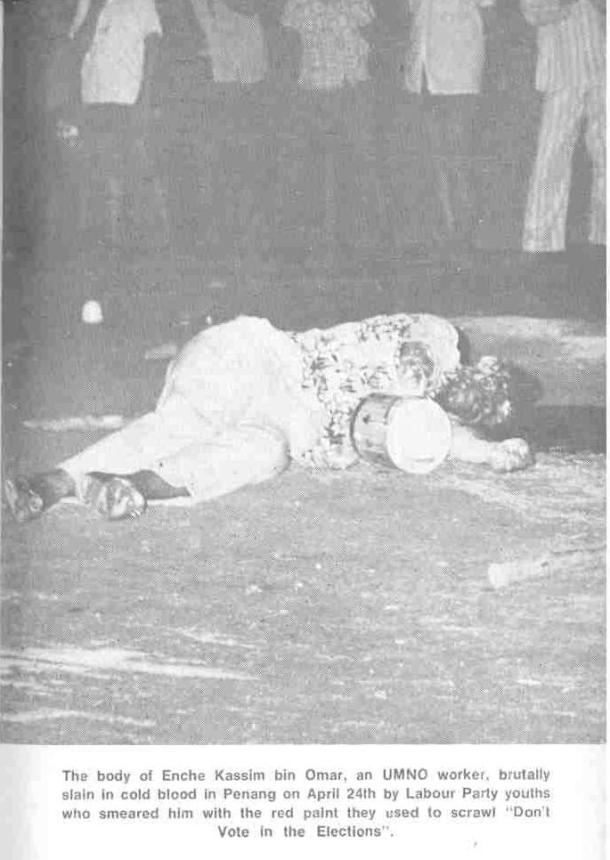
Kua Kia Soong purposely did not mention this story because he wanted to put forth his third conclusion.
The Run-up to General Election of 1969
Kua Kia Soong’s analyses in his book only started from this point onwards although he still missed out several more pertinent points.
The May 13th general election had an unprecedented long campaign period. One month to be precise. Under the pretext of freedom of speech yet with rising racial tension in the background it was an unfortunate decision to be made by the government to grant a long campaigning period at that time.
The communist infested Labour Party instigated the nation by announcing in October 1968 they will boycott the 1969 general election. This left the opposition front to consist only the DAP, Gerakan, PPP and the PMIP (Pan Malaysian Islamic Party or PAS). The supporters of Labour Party then threw their weights in support of the DAP and Gerakan during the campaigning period.
They sense the government had already weakened by the racial intimidation and tension ignited by them and they were willing to divide the nation further in their campaigning strategy.
Using Kua Kia Soong’s own words -
“Thus, on the eve of the 1969 general election we saw on the one hand, PMIP (PAS) accusing UMNO of having ‘sold out’ the Malays to the Chinese and betrayed Islam; on the other, DAP accusing MCA of having “sold out” non-Malay rights to Umno” (pg 32).
So which is which? Their line of reasoning was indeed preposterous and illogical.
But this modus operandi remains the same till this day. They slandered the government through this racist method of divide and conquer and yet, they have the gall to call the Alliance (now Barisan Nasional) as racist!
Both PAS and DAP had different idealogies and yet they were willing to cooperate using DIFFERENT approach in their campaigns and the unassuming public bought their sickening propaganda! The result?
Again Kua Kia Soong’s succinctly summarized that “among the Chinese, the Alliance Party’s policy was seen as excessively favoring the Malays, while among the Malays, the Alliance Party’s policies were regarded as not getting results fast enough” (pg 37).
But who pounded these beliefs into the hearts and minds of both Malays and chinese? It’s non other than the opposition themselves.
Hence we have the ultimate hypocrisy of PAS chastising Umno for working with MCA instead of pursuing Hudud but at the same time can work in tandem with the DAP in a coalition. DAP meanwhile criticise MCA and Gerakan for kow-towing with Umno but the party itself failed to look in the mirror whenever they fawn over and hug PAS leaders in the opposition coalition.
Please re-read what Kia Kua Soong had wrote in the two excerpts above and juxtapose them with the current cries of racism that the opposition love to scream about these days.
Anyway, six days before the 1969 elections, 3 police constables came across a group of youths from the Labour Party painting anti-election slogans on the road. When challenged by the police, they attacked using iron rods and hurling firewood and stones. They put up such a fight that the police had to open fire in self defense. One of the youth was wounded and died later in the hospital.
The opposition took advantage of the youth’s death and wanted to organise a large funeral procession on the polling day itself! See the intended malice? Did Umno leaders organised a similar procession when Encik Kassim Bin Omar was killed as shown above? Compare the two incidents and we know who were the racist among them.
Anyway, the police together with the permission from the Home Ministry however, gave the permit for the procession to be held on the 9th instead.
This funeral procession, although larger in scale compared to the recent suspected car thief’s funeral procession was the tipping point of the Malays’ anger towards the chinese.
One of the documents which were considered ‘declassified’ was Bob Reece’s article in FEER in May 1969. Kua Kia Soong used an excerpt from it to establish that the funeral procession was very disciplined and well behaved (thus trying very hard to absolve any wrongdoing of the opposition).
“While it was true that some Mao-slogans and flags were seen during this parade, the discipline of the 14,000-strong crowd in their eight-mile march may have been due to genuine restraint rather than to communist organization.” (pg 27)
There you go. A British journalist who probably forgot to bring his glasses that day. The only side that had genuine restraint were the Malays watching the ruthless and taunting procession.
For eight miles the chauvinistic chinese marched.
The sight of the jeering hooligans marching slowly around the city for that many miles must have been an agonizing experience to bear for the Malays then. And yet, they chose to be patient.
They chanted Maoist slogans, sang ‘The East is Red’, and displayed portraits of Mao Tse-tung and the Red flag. The procession passed through the heart of Kuala Lumpur and tied up traffic in almost every major street in the city and provoked Malay bystanders with shouts of ‘Malai si!’ (Death to the Malays) and ‘Hutang darah bayar darah’ (Blood debt will be repaid with blood).
Pictures say a thousand words. Here they are:
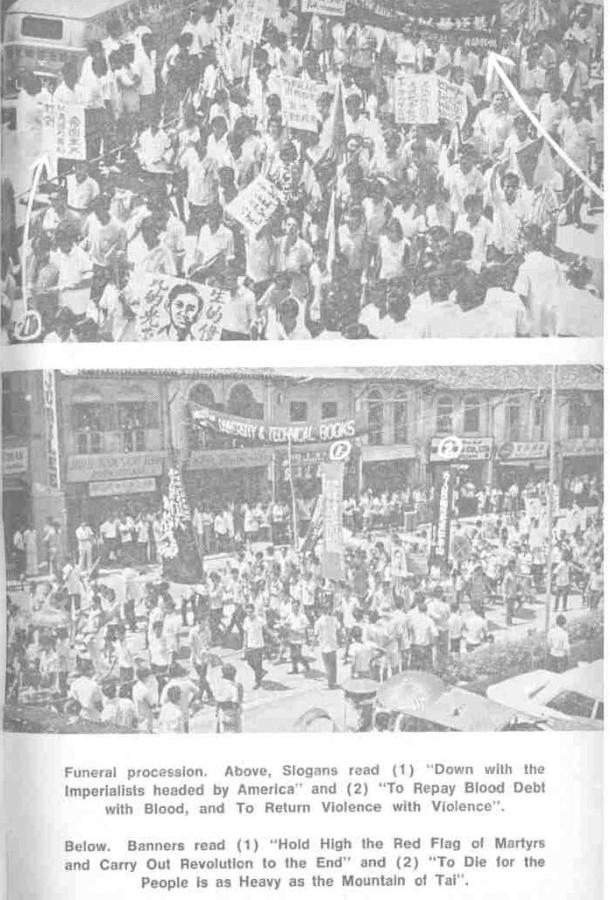
Bystanders watching the procession went by with all the taunting slogans in the midst
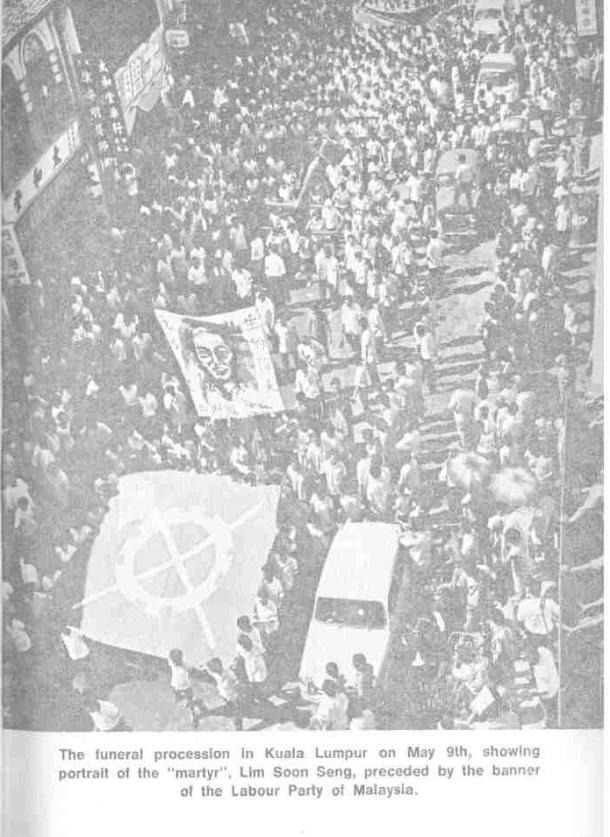
14,000 thousand people marched through the city into the Malay areas
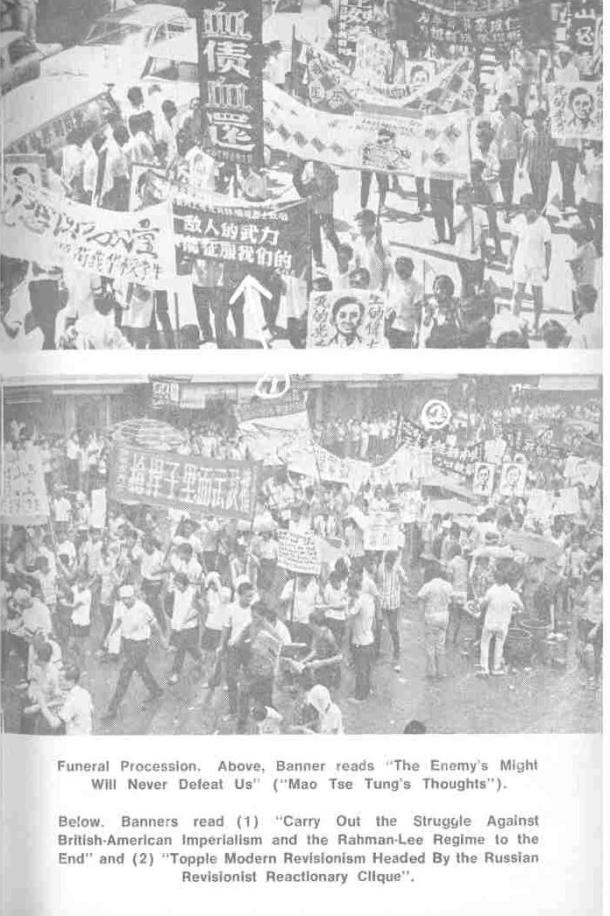
The communist sympathisers taunting the Malays with Chairman Mao's idealogy
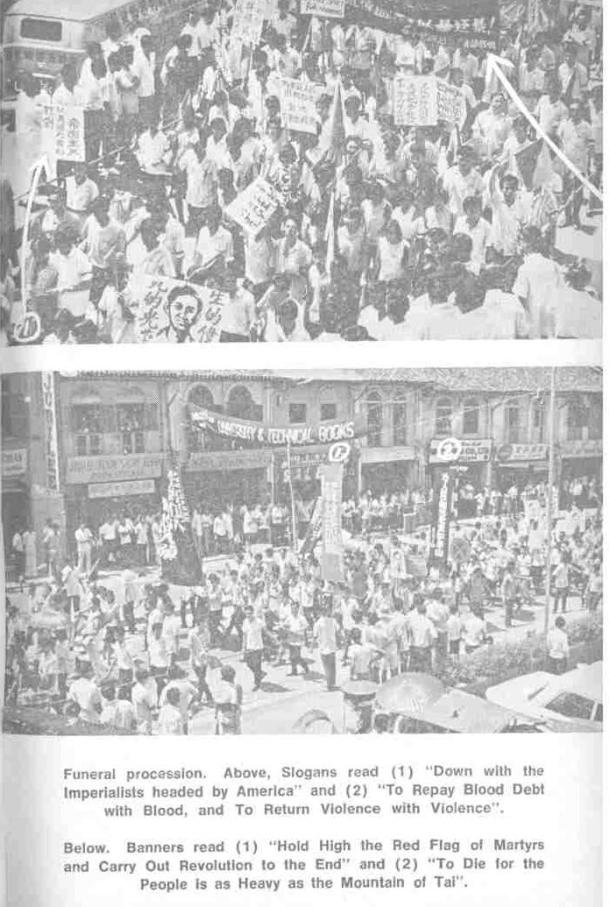
Is this what we can call as communist-free procession?
Did Kua Kia Soong mention any of these in his book? Of course he didn’t. Even to show these pictures will be damaging to his third conclusion stated at the beginning of this article.
4 days after this funeral procession, when an election victory march was held all over the city again, it broke the ever tolerant Malay psyche. That was the straw that broke the camel’s back.
Today, Farish Noor wrote an article about May 13 and I am very disappointed that he chose to ignore all the above facts and proceeded to write that May 13 WAS NOT the result of a racial conflict. That is not the truth.
My next article will continue to discuss the events that happened after the victory procession of the opposition for the 2 days before May 13.
I will also lay out the retaliation by the Malays that ran amok on May 13, Umno’s role at that time and the reconciliation process between the people. We will also discuss whether the first two conclusions of the book were correct.
I reiterate the purpose of this article – which is to straighten out the lies some people are telling to young Malaysians. In order to clear the path for a united Malaysia, history must be made known as it is. Only then we can tell straight to each other’s face – ‘how lucky we are now’.
There is hope though. Anas Zubedy’s article here is a refreshing read and I applaud it. But only after we really know what happened in the past that we can face the future in a positive way. Maybe starting next year, we can all celebrate National Harmony Day on May 13 each year.
For the time being, please click on the articles below for a better view of what had happened prior to May 13 (zoom on it if you have to). They are a must read before we proceed later on in part 2.
Addendum
Tonight there will be a public forum in MBPJ Selangor. If Lim Kit Siang was asked what was his involvement during the whole nightmare in 1969, I would be curious to know his answer. I hope he can maintain a straight face when answering especially when Dollah Kok Lanas is going to be one of the speakers.
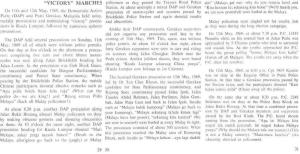
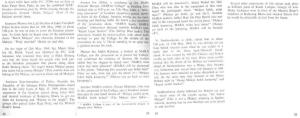
























No comments:
Post a Comment